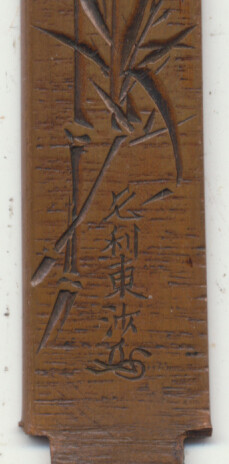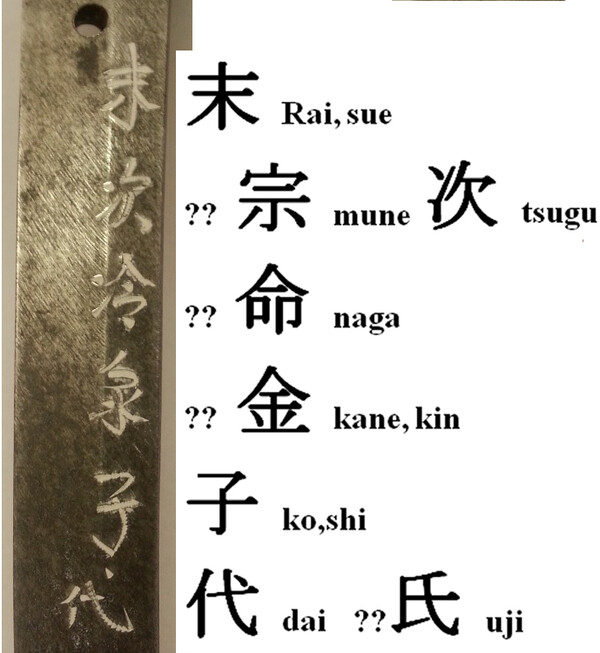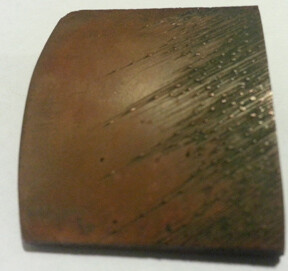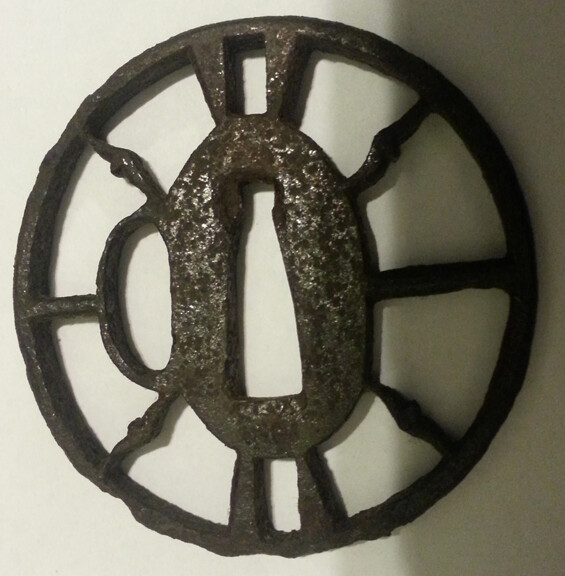
David McDonald
Members-
Posts
237 -
Joined
-
Last visited
Content Type
Profiles
Forums
Events
Store
Downloads
Gallery
Everything posted by David McDonald
-
nagahiro? Am I finally getting this right :)
David McDonald replied to hmultimedia's topic in Translation Assistance
Dear Matt I found one reference for Washu ju Nagahiro in Nihonto Meikan with a period of eisho (1504) and he worked in Iwami province. Not sure if it is your smith but a start. later david mcdonald jswords@mcn.net -
Dear John Bamboo, older the better, wall thickness in the 1-1.5 cm or more. If it has been close to a fireplace so has been smoked for many years even better. The joints will be in the 10 to 20 cm range so was closer to the bottom of the plant. diameter in the 10 cm to 20 cm range. The key is to have the individual fibers closely packed (end grain of the bambo). Most likely a name for this but I do not know. If you have something like that I can paypal you the cost of the tools and mailing and for your time and once I get the package will be happy to cut up in small strips and resale at costs to all on the board that are interested. The strips are about 0.8 cm to 1.0 cm wide and thick (cutting off the inner softer parts). Maybe there are others in other countries who would also do something like this. But I can mail all over the world. What ever works. You can buy a bamboo saw at Tokyo Hands (a hardware store). And there is a bamboo fro (a hatchet like tool to split bamboo). send an email to jswords@mcn.net with a paypal account and I can send you some money to get the tools and postage up front if needed. thanks david mcdonald jswords@mcn.net
-
Dear John Something a number of us on the list would be interested in is pieces of very old bamboo to make mekugi. If you ran across anything like that I would be interested. I got some a few years ago from a about 150 year old restaurant. Sure makes nice mekugi. Just a thought. david mcdonald jswords@mcn.net
-
Dear Adam I like it also. I picked it up to study how the carvings were done. In the week long class taught by Ford Hallam, I did work on carving some bamboo. Now I will see what my work looks like on a kogatana. Email me if you would like a student project work. later david mcdonald jswords@mcn.net
-
Dear All I picked up a copper kozuka blade (kogatana) with nice carvings. I do not remember seeing one before. Were vary many made? Did a fittings maker make it or was it a sword smith? I think with the carving it would be a fittings maker. The piece is signed ? 利Ri, toshi, yoshi, sato,to, nori,kaga,kazu 東Tō, azuma, higashi, moto, haru, hide ? I have not found him listed yet. Any thought would be great. later david mcdonald jswords@mcn.net
-
Dear Stephen Easy but.... I thought you were talking about a cardinal number and thought I knew them so had to look. No not the cardinal number. So looked up 100 and then 1000. Is this it?? 千 Ok so I think I found it but what does it mean. I have never see this on a sword before???? I cropped and rotated the image. later david mcdonald jswords@mcn.net
-
signature on broken sword
David McDonald replied to David McDonald's topic in Translation Assistance
Dear Sebastian and George Thanks for looking and the leads. later david mcdonald jswords@mcn.net -
Dear All The image is from a katana that has had 1/3rd of the blade broken off (tip part) and then reshaped. So is a dead sword. But it had a nice copper habaki. But I can not work out the translation. I almost think this is 27th generation Kaneko Kanemote but maybe not. Any ideas what the translation is or who the smith is? Later david mcdonald jswords@mcn.net
-
Dear All Is there an article/web site or book that talks about the terms used in the actual signing of the nakago on a Japanese sword and fittings. I am not talking about the content but how they make the marks. Or what are your thoughts. Maybe atari and tanegane/tagane??? I see that some swords have the many little triangles lined up to make the kanji and some seemed more carved. And most tsuba seems to have the kanji carved but a few have the little triangles. Thanks for any help David McDonald jswords@mcn.net
-
Tsuka question
David McDonald replied to Jason Williams's topic in General Nihonto Related Discussion
Dear Brian You can also wrap the tsuka with same-gawa 1 1/2 times and have the seam on the mune side and not seen. You can also have a full wrap where there is an over lap at the mune and so no seam that is seen. later david -
Source needed for Tsunagi
David McDonald replied to Ed Hicks's topic in General Nihonto Related Discussion
Dear Ed Here is a thought. Set the saya onto a long strip of paper. This will allow you to trace the shape/curvature. Use a long thin rod to determine the length inside the saya. Use a caliper to measure the thickness and width at the koiguchi. Use this information to modify the tracing from the saya. Then use the thin rod to measure the length inside the tsuka. Use the caliper to measure the thickness and width at the fuchi opening. Add this information to the modified tracing from the saya. If the length on the saya is reduced by about 1-3 cm then a blank tsunagi can be easily made. You then take the blank and file to fit. Takes a little bit of time but works. I have ho-wa and can make the blanks if you are interested. Cost $50 each or you buy a stick of ho-wa ($100 each) and you cut?? You can also use popular or ash. later david mcdonald jswords@mcn.net -
Dear Kyle sorry I can not help with your questions but would like to see more images of the tsuka-maki. Images of both sides, close up of the area where the two colors meet?? I think it would be interesting to see if I can do the same type of tsuka-maki. thanks david mcdonald jswords@mcn.net
-
Mei for translation and which generation
David McDonald replied to steve oakley's topic in Translation Assistance
Dear Steve Could it be Kaneharu 兼流 Just a thought later david mcdonald jswords@mcn.net -
Dear George Here are some images. Not much to see. The sword had been rusted/pitted. Last owner used a sander on the blade. Rounded over the shinogi and mune. Left some deep gouges. The sword will need a polisher to set it right. The hamon is not a straight line suguha but suguha with very small gunome. A few places it looks like a very narrow nioi. The post viewtopic.php?f=15&t=14628&p=127923&hilit=Kokura+Rikugun+Zoheisho#p127923 Has much the same signature but with a 1944 date. We now have two swords signed this way? Might the smith just not like the blade and choice not to put his name on the sword? later david mcdonald jswords@mcn.net
-
Dear All Just as a note Chris Bowen at viewtopic.php?f=15&t=14628&p=127923&hilit=Kokura+Rikugun+Zoheisho#p127923 has translated Kokuri Rigun Zōheisō as for the signature and at viewtopic.php?f=9&t=7146&p=57017&hilit=Kokura+Rikugun+Zoheisho#p57017 George has Do one of these smiths use a chu suguha in nioi and koshiba??? So what is a star stamp that is dated but no tosho mei just Kokuri rigun Zoheiso????? later david mcdonald jswords@mcn.net
-
Dear All Not sure if this is the correct area of the board but is a start. Star stamp Kokuri Rikugun Zōheisō 小倉 陸軍 造兵 Showa ni ju nen ni gatsu 昭和二十年二月 On mune two katakana – Ri Ri リリ (maybe two ko 小小with missing stroke?) So is this a gendaito? And who would be the smith? The blade has been sand papered so can not see much but there is a chu suguha in nioi With koshiba in the ura side. And I can see one slanted peak in the hamon. The peak goes up about 3 mm above the suguha. Boshi is ko-maru. Any thoughts would be great. thanks david mcdonald jswords@mcn.net
-
Help Translating WWII sword signature.
David McDonald replied to Edward G's topic in Translation Assistance
Dear Edward Osugi a town in Noshu is above ju 大杉 later david -
Help Translating WWII sword signature.
David McDonald replied to Edward G's topic in Translation Assistance
Dear Edward below ju is Ishihara 石原 later david -
Can anyone tell me what this style is called?
David McDonald replied to Robert Housley's topic in Nihonto
Dear Grey Sorry Grey but I do not do Jabara - string wrap. I sat and watched Ichinose sensei do a string wrap in the 1980's and while it was great to watch him do it, it is not fun to work with 8 - 1 mm wide strings. The tsuka with the green ito has very good-looking open diamonds. It also looks to be 2 mm wide strings. I have not seen that on antique tsuka. As Jussi noted "But I believe Kumiage Maki is correct, see Kensen's answer in this thread: http://www.thejapanesesword.com/forum/v ... f=29&t=133 And Florian's linked pic is made by Yasuo Toyama and it's also called Jabara Kumiage Maki." I can do the Kumiage maki. The tsuka at http://www.thejapanesesword.com was a tsuka that I had to rewrap. As you touched the old ito, it was turning into dust. It took a number of practice tsukas before I got the knack of this style. later david mcdonald jswords@mcn.net ] -
Tsuka Maki Wrapping Stand
David McDonald replied to Uechi's topic in General Nihonto Related Discussion
Dear Jeff With Stephen's link you did find me and I emailed back. Thanks Stephen. later david mcdonald jswords@mcn.net -
fujiwara jumyō - presentation inscription?
David McDonald replied to Cuirassier's topic in Translation Assistance
Dear All ok Fujiwara Jumyo kore 藤原壽命之 I agree. sorry about that later david -
fujiwara jumyō - presentation inscription?
David McDonald replied to Cuirassier's topic in Translation Assistance
Dear Mark Under the showa stamp I see Fujiwara Munenaga kore 藤原宗命之 Might be the smith Nishibe Munenaga see Hawley MUN297 later david mcdonald jswords@mcn.net -
Dear Donny The date kanji are 皇Ko 紀ki (Koki - from the foundation of the empire in 660BC) 二ni - 2 千sen - 1000 六roku - 6 百hyuku (100 I think) 二ni - 2 ( so 2602 years after 660 bc) 年nen - year (I think) 吉kichi 日nichi (Not sure of last two kanji) I have a not for a shigefusa that worked in Tokushima for the Army Blade department And a Genbusai (Kojima) Shigefusa that also signed Zuihu Not sure if these are your smith or not good luck on your research later david mcdonald jswords@mcn.net
-
Dear Patrik They are two smiths Munekazu that worked in Musashi 1st gen worked in Edo 1854-1861 also signed Honjo ju Matsuura Jibe Mukoyama Munekazu and oite Saihi Hirado Minamoto Munekazu tankore 2nd gen worked in Edo 1864 signed Getsu Shinsai Munekazu Hope this helps david mcdonald jswords@mcn.net













